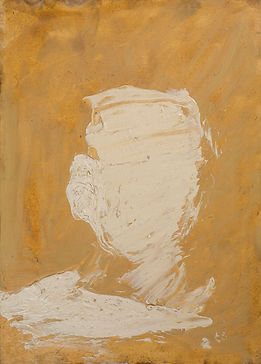
Pierre Tal Coat

Sophia Fassi

Jean-Pierre Schneider

Jean Fautrier

Pierre Buraglio
FACE AU VISAGE
January 11 - February 17 2024
Au 14 rue de Seine
75006 PARIS
Du 11 janvier jusqu'au 17 février la Galerie propose une exposition s'articulant autour des questions du portrait et du visage en lien avec la sortie du nouvelle ouvrage d'Itzhak Goldberg, Face au visage*, paru aux éditions Citadelles&Mazenod.
Né en 1949, Itzhak Goldberg est un historien de l'art, professeur émérite de la faculté de Jean Monnet. En tant que chercheur, ses recherches se concentrent surtouts sur les sujets de la représentation et la défiguration du paysage et du visage dans l'art moderne et contemporain.
Portraits ou visages ? Les œuvres réunies à la Galerie Berthet-Aittouarès oscillent entre ces deux termes, à priori considérés comme des synonymes.
En réalité, bien qu’ils entretiennent des liens de fraternité, ils ont eu chacun leur propre fortune, parallèle et lointaine. Dès la modernité, la figure humaine n’est plus asservie aux impératifs d’une imitation fidèle qui caractérisait le portrait, et n’en fait souvent qu’à sa tête. De fait, si l’Autoportrait de Tal-Coat de 1935, où l’artiste se montre dans son atelier, pinceau et palette à la main, conserve encore une mise en scène traditionnelle, celui de 1980, entièrement englouti dans la matière, a perdu définitivement ses traits. Ce visage, comme celui de Jean-Pierre Schneider (Pierre de Wissant), incarne une confrontation entre l’informe et la forme en devenir, entre la ligne et la masse. Ici, le malaxage, témoignage direct du processus de création, aboutit à des figures de défiguration indissociables de la matière, aux formes naissantes qui renvoient à l’idée des origines, de l’archétype, du visage « primitif » dans sa forme matricielle.
Ailleurs, avec l’Hommage à Cézanne de Pierre Buraglio, le visage, disloqué, fragmenté, résiste encore, offrant au spectateur quelques détails reconnaissables, comme une ressemblance résiduelle. Ailleurs encore, les visages grimaçants de Boltanski dans les Saynètes comiques, The birthday de 1974, ou le réalisme troublant du portrait de Monika, SDF de l’avenue de Suffren réalisé par la jeune peintre Sophia Fassi, ou encore le « jeu des rôles » de Nil Yalter, déguisée ironiquement en soubrette pour un dîner officiel au Centre Pompidou, ne sont que quelques exemples d’un face à face toujours renouvelé.
Itzhak Goldberg
*Itzhak Goldberg, Face au visage, Citadelles&Mazenod, Paris, 2023.
From January 11 to February 17, the Galerie is staging an exhibition focusing on portraiture and the face, in conjunction with the publication of Itzhak Goldberg's new book, Face au visage*, edited by Citadelles&Mazenod.
Born in 1949, Itzhak Goldberg is an art historian and professor emeritus at the Jean Monnet faculty. As a researcher, his work focuses on the representation and disfiguration of landscape and the face in modern and contemporary art.
Portraits or faces? The works brought together at the Galerie Berthet-Aittouarès exhibition oscillate between these two terms, which might at first sight be considered synonymous.
In reality, although they are closely related, they have each had their own parallel and distant fortunes. In modern art, the human figure is no longer subject to the imperatives of faithful imitation that characterised portraiture, and often does as it pleases. In fact, while Tal-Coat's 1935 Self-portrait, in which the artist is shown in his studio, brush and palette in hand, still retains a traditional staging, the 1980 portrait, completely engulfed in matter, has lost its features for good. This face, like that of Jean-Pierre Schneider (Pierre de Wissant), embodies a confrontation between formlessness and form in the making, between line and mass. Here, the kneading process, a direct testimony to the creative process, results in figures of disfigurement that are inseparable from the material, in nascent forms that hark back to the idea of origins, of the archetype, of the 'primitive' face in its matrix form.
Elsewhere, in Pierre Buraglio's Hommage à Cézanne, the face, dislocated and fragmented, still resists, offering the viewer a few recognisable details, like a residual resemblance. Elsewhere, Boltanski's grimacing faces in Saynètes comiques, The birthday from 1974, or the disturbing realism of the portrait of Monika, a homeless woman on the Avenue de Suffren painted by the young painter Sophia Fassi, or Nil Yalter's "role-playing", ironically disguised as a soubrette for an official dinner at the Centre Pompidou, are just a few examples of an ever-renewed face-to-face encounter.
Itzhak Goldberg
*Itzhak Goldberg, Face au visage, Citadelles&Mazenod, Paris, 2023.
MEETING
ITZHAK GOLDBERG
Interview with Itzhak Goldberg as part of the Face au visage exhibition : Link here

Nil Yalter

Antoine Schneck





